CHEVROLET ASTRO 1996 Owners Manual
Manufacturer: CHEVROLET, Model Year: 1996, Model line: ASTRO, Model: CHEVROLET ASTRO 1996Pages: 372, PDF Size: 21.51 MB
Page 341 of 372
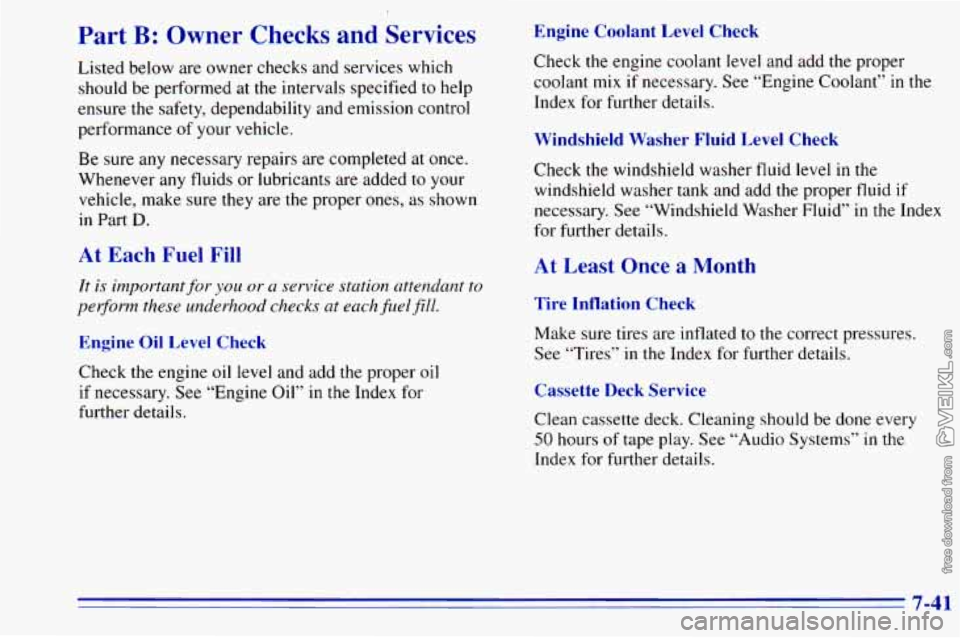
Part B: Owner Checks and Services
Listed below are owner checks and services which
should be performed at the intervals specified
to help
ensure the safety, dependability and emission control
performance of your vehicle.
Be sure
any necessary repairs are completed at once.
Whenever
any fluids or lubricants are added to your
vehicle, make sure they are the proper ones, as shown
in Part
D.
At Each Fuel Fill
It is important for you or a service station attendant to
perform these underhood checks at each
filelfill.
Engine Oil Level Check
Check the engine oil level and add the proper oil
if necessary. See “Engine Oil” in the Index for
further details.
Engine Coolant Level Check
Check the engine coolant level and add the proper
coolant mix if necessary. See “Engine Coolant” in the
Index for further details.
Windshield Washer Fluid Level Check
Check the windshield washer fluid level in the
windshield washer tank and add the proper fluid if
necessary. See “Windshield Washer Fluid”
in the Index
for further details.
At Least Once a Month
Tire Inflation Check
Make sure tires are inflated to the correct pressures.
See “Tires” in the Index for further details.
Cassette Deck Service
Clean cassette deck. Cleaning should be done every
50 hours of tape play. See “Audio Systems” in the
Index for further details.
7-41
Page 342 of 372
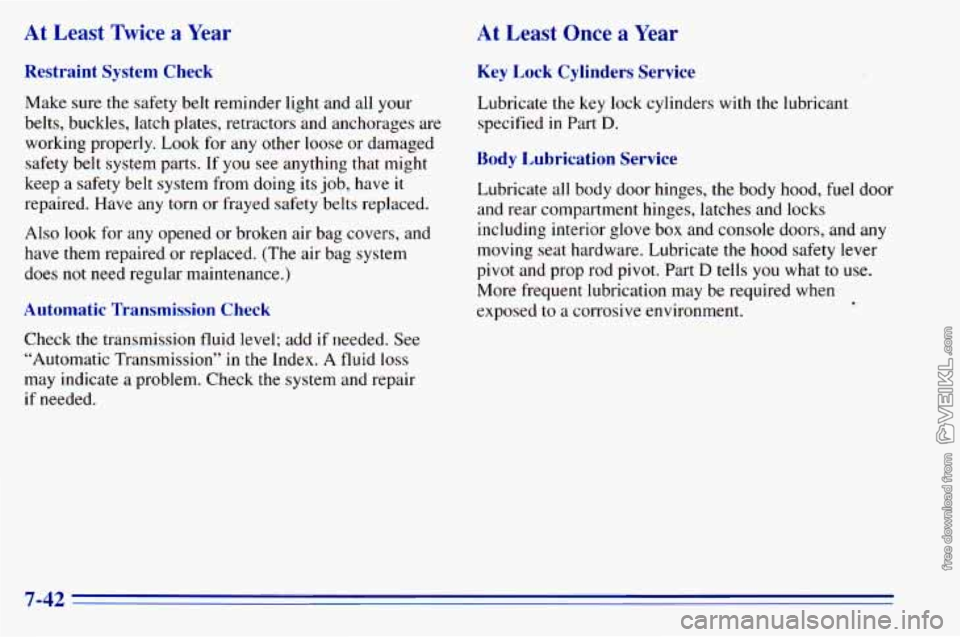
At Least Twice a Year
Restraint System Check
Make sure the safety belt reminder light and all your
belts, buckles, latch plates, retractors and anchorages are
working properly.
Look for any other loose or damaged
safety belt system parts. If you see anything that might
keep a safety belt system from doing its job, have it
repaired. Have any torn or frayed safety belts replaced.
Also look for any opened or broken air bag covers, and
have them repaired or replaced, (The air bag system
does not need regular maintenance.)
Automatic Transmission Check
Check the transmission fluid level; add if needed. See
“Automatic Transmission’’ in the Index. A fluid
loss
may indicate a problem. Check the system and repair
if needed.
At Least Once a Year
Key Lock Cylinders Service
Lubricate the key lock cylinders with the lubricant
specified in Part
D.
Body Lubrication Service
Lubricate all body door hinges, the body hood, fuel door
and rear compartment hinges, latches and locks
including interior glove box and console doors, and
any
moving seat hardware. Lubricate the hood safety lever
pivot and prop rod pivot. Part
D tells you what to use.
More frequent lubrication may be required
when
exposed to a corrosive environment.
7-42
Page 343 of 372
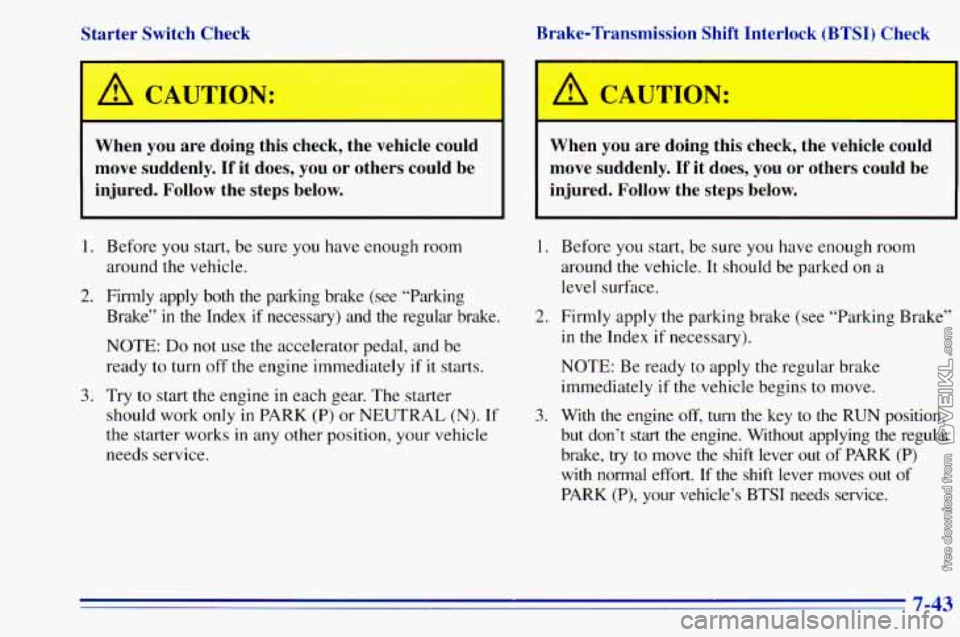
Starter Switch Check When you are doing this check, the vehicle could
move suddenly. If it does, you or others could be
injured. Follow the steps below. Brake-Transmission Shift Interlock (BTSI) Check
c
,A CAUTION:
When you are doing this check, the vehicle could
move suddenly. If
it does, you
or others could be
injured. Follow the steps below.
1. Before you start, be sure you have enough room
around the vehicle.
2.
3.
Firmly apply both the parking brake (see “Parking Brake” in the Index
if necessary) and the regular brake.
NOTE: Do not use the accelerator pedal, and be
ready to turn
off the engine immediately if it starts.
Try
to start the engine in each gear. The starter
should work only
in PARK (P) or NEUTRAL (N). If
the starter works in any other position, your vehicle
needs service.
1. Before you start, be sure you have enough room
around the vehicle. It should be parked on a
level surface.
2.
3.
Firmly apply the parking brake (see “Parking Brake”
in the Index if necessary).
NOTE: Be ready to apply the regular brake
immediately
if the vehicle begins to move.
With the engine
off, turn the key to the RUN position,
but don’t start the engine. Without applying the regular
brake, try to move the shift lever out of PARK
(P)
with normal effort. If the shift lever moves out of
PARK (P), your vehicle’s BTSI needs service.
7-43
Page 344 of 372
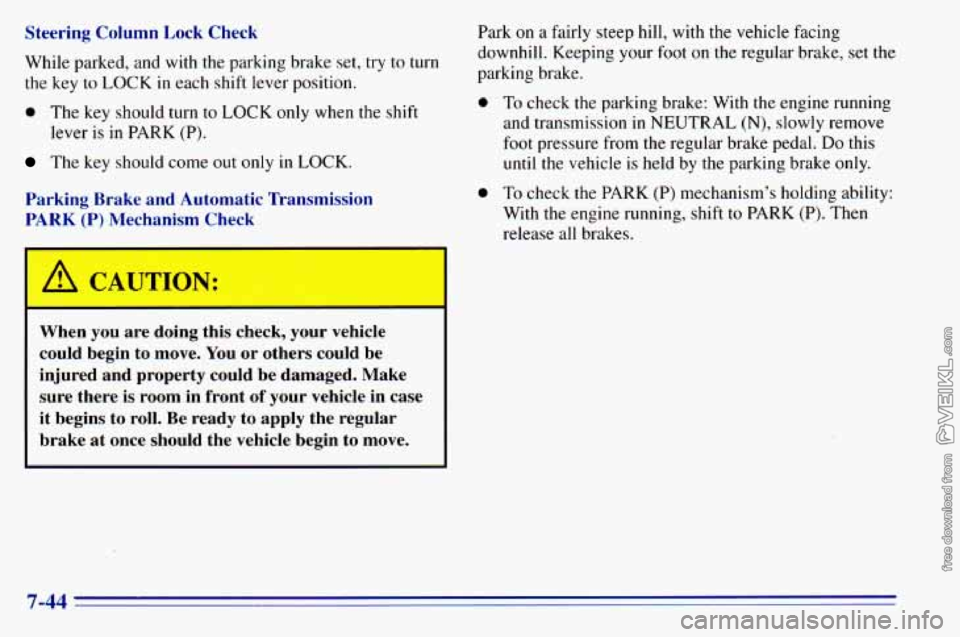
Steering Column Lock Check
While parked, and with the parking brake set, try
to turn
the key to
LOCK in each shift lever position.
0 The key should turn to LOCK only when the shift
lever is in PARK (P).
The key should come out only in LOCK.
Parking Brake and Automatic Transmission
PARK (P) Nlorhanism Check Park
on a fairly
steep hill, with the vehicle facing
downhill. Keeping your foot on the regular brake, set the
parking brake.
0 To check the parking brake: With the engine running
and transmission
in NEUTRAL (N), slowly remove
foot pressure from the regular brake pedal.
Do this
until the vehicle is held by the parking brake only.
0 To check the PARK (P) mechanism’s holding ability:
With
the engine running, shift to PARK (P). Then
release all brakes.
A CAUTION:
r
When you are doing this check, your vehicle
could begin to move. You or others could be
injured and property could be damaged. Make
sure there is room in front
of your vehicle in case
it begins to roll. Be ready to apply the regular
brake at once should the vehicle begin to move.
7-44
Page 345 of 372

Part C: Periodic Maintenance
Inspections
Listed below are inspections and services which should
be performed
at least twice a year (for instance, each
spring and fall). You should let your GM dealer’s
service department or other qualified service center do
these jobs. Make sure any necessary repairs are
completed at once.
Proper procedures to perform these services may be
found
in a GM Service Manual. See “Service and Owner
Publications’’
in the Index.
Steering and Suspension Inspection
Inspect the front and rear suspension and steering
system for damaged, loose or missing parts, signs of
wear or lack of lubrication. Inspect the power steering
lines and hoses for proper hook-up, binding, leaks,
cracks, chafing, etc.
Exhaust System Inspection
Inspect the complete exhaust system. Inspect the body
near the exhaust system. Look for broken, damaged,
missing or out-of-position parts as well as open seams,
holes, loose connections
or other conditions which could
cause a heat build-up
in the floor pan or could let
exhaust fumes into the vehicle. See “Engine Exhaust’’
in the Index.
Radiator and Heater Hose Inspection
Inspect the hoses and have them replaced if they are
cracked, swollen or deteriorated. Inspect all pipes,
fittings and clamps; replace as needed.
Throttle Linkage Inspection
Inspect the throttle linkage for interference or binding,
and for damage or missing
parts. Replace parts as
needed. Replace any cables
that have high effort or
excessive wear.
Do not lubricate accelerator and cruise
control cables.
7-45
Page 346 of 372
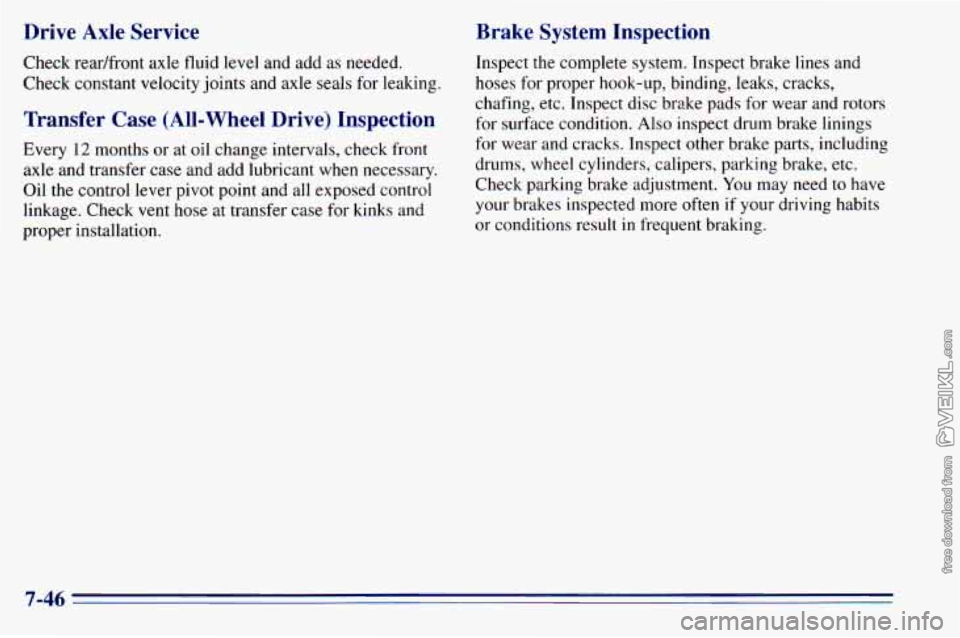
Drive Axle Service
Check readfront axle fluid level and add as needed.
Check constant velocity joints and axle
seals for leaking.
Transfer Case (All-Wheel Drive) Inspection
Every 12 months or at oil change intervals, check front
axle and transfer case and add lubricant when necessary.
Oil the control lever pivot point and all exposed control
linkage. Check vent hose at transfer case for kinks and
proper installation.
Brake System Inspection
Inspect the complete system. Inspect brake lines and
hoses for proper hook-up, binding, leaks, cracks,
chafing, etc. Inspect disc brake pads for wear and rotors
for surface condition. Also inspect drum brake linings
for wear and cracks. Inspect other brake parts, including
drums, wheel cylinders, calipers, parking brake, etc.
Check parking brake adjustment.
You may need to have
your brakes inspected more often if your driving habits
or conditions result in frequent braking.
7-46
Page 347 of 372
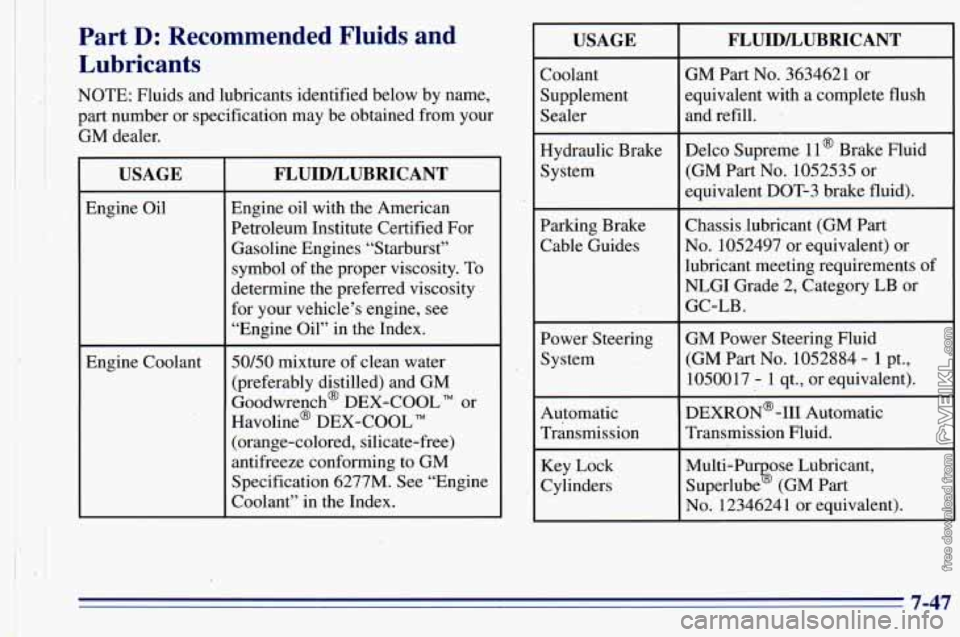
Part D: Recommended Fluids and
Lubricants
NOTE: Fluids and lubricants identified below by name,
part number or specification may be obtained from your
GM dealer.
USAGE
Engine Oil
Engine Coolant
FLUID/LUBRICANT ~~~ ~
Engine oil with the American
Petroleum Institute Certified For Gasoline Engines “Starburst”
symbol of the proper viscosity. To
determine the preferred viscosity
for your vehicle’s engine, see
“Engine Oil’’ in the Index.
~~
50/50, mixture of clean water
(preferably distilled) and GM
Goodwrench@ DEX-COOL
TM or
Havoline@ DEX-COOL
TM
(orange-colored, silicate-free)
antifreeze conformiag to GM
Specification 6277M. See “Engine
Coolant” in the Index.
USAGE
Coolant
Supplement
Sealer
Hydraulic Brake
System
~~~~~~~
Parking Brake
Cable Guides
Power Steering
System
Automatic
Transmission
Key Lock
Cylinders
FLUIDLUBRICANT
GM Part No. 3634621 or
equivalent with a complete flush
and refill.
-
Delco Supreme 11 @ Brake Fluid
(GM Part No. 1052535 or
equivalent DOT-3 brake fluid).
Chassis.1ubricant (GM Part
No. 1052497 or equivalent) or
lubricant meeting requirements of
NLGI Grade 2, Category
LB or
GC-LB.
GM Power Steering Fluid
(GM Part No. 1052884
- 1 pt.,
1050017
- 1 qt., or equivalent).
DEXRON@-I11 Automatic
Transmission Fluid.
Multi-Pu ose Lubricant,
Superlube
% (GM Part
No. 1234624 1 or equivalent).
7-47
Page 348 of 372
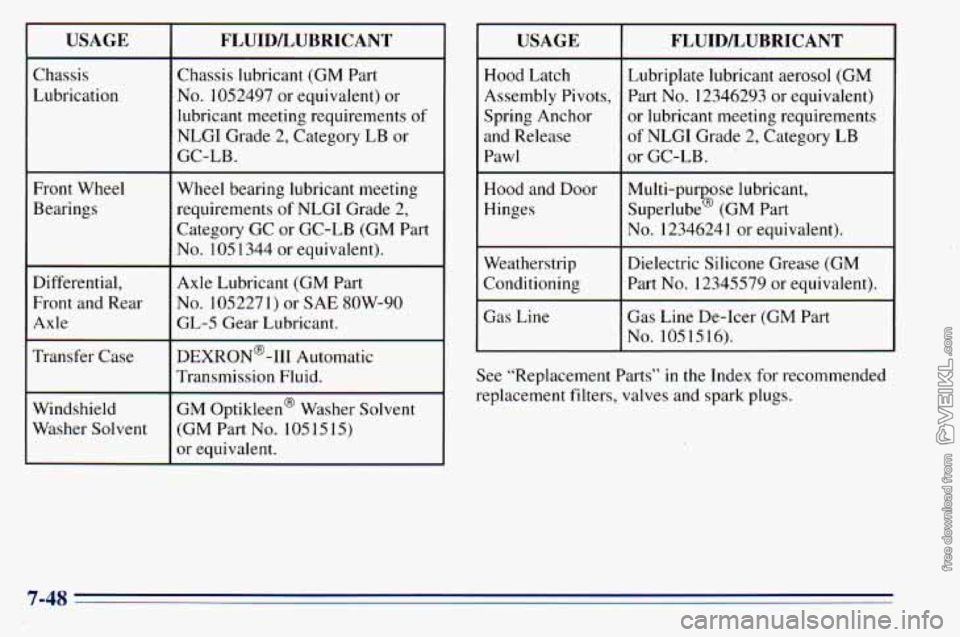
USAGE
Chassis
Lubrication
Front Wheel
Bearings
Differential,
Front and Rear
Axle
Transfer Case
Windshield
Washer Solvent
FLUIDLUBRICANT
Chassis lubricant (GM Part
No. 1052497
or equivalent) or
lubricant meeting requirements of
’ NLGI Grade 2, Category LB or
GC-LB.
Wheel bearing lubricant meeting
requirements
of NLGI Grade 2,
Category GC or GC-LB (GM Part
No.
105 1344 or equivalent).
Axle Lubricant (GM Part
No. 105227 1) or SAE
8OW-90
GL-5 Gear Lubricant.
DEXRON@-111 Automatic
Transmission Fluid.
GM Optikleen@ Washer Solvent
(GM Part
No. 1051515)
or equivalent.
USAGE
Hood Latch
Assembly Pivots,
Spring Anchor
and Release
Pawl
Hood and Door
Hinges
Weatherstrip
Conditioning
Gas Line
FLUIDLUBRICANT
Lubriplate lubricant aerosol (GM
Part
No. 12346293 or equivalent)
or lubricant meeting requirements
of NLGI Grade 2, Category LB
or GC-LB.
Multi-pu ose lubricant,
Superlube
% (GM Part
No. 1234624
1 or equivalent).
Dielectric Silicone Grease (GM
Part No. 12345579 or equivalent).
Gas Line De-Icer (GM Part
No. 105 15
16).
See “Replacement Parts” in the Index for recommended
replacement filters, valves and spark plugs.
Page 349 of 372
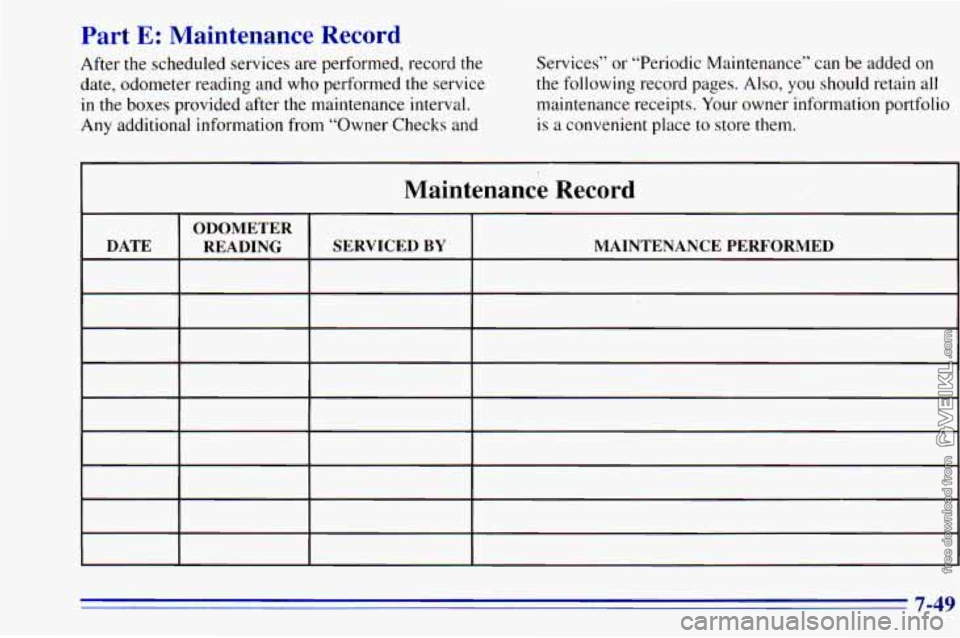
Part E: Maintenance Record
After the scheduled services are performed, record the
date, odometer reading and who performed
the service
in the boxes provided after the maintenance interval.
Any additional information from “Owner Checks and aervices”
or “Periodic Maintenance” can be added on
the following record pages. Also, you should retain all
maintenance receipts. Your owner information portfolio
is a convenient place to store them.
Maintenance Record
ODOMETER
DATE READING SERVICED
BY MAINTENANCE PERFORMED
7-49
Page 350 of 372
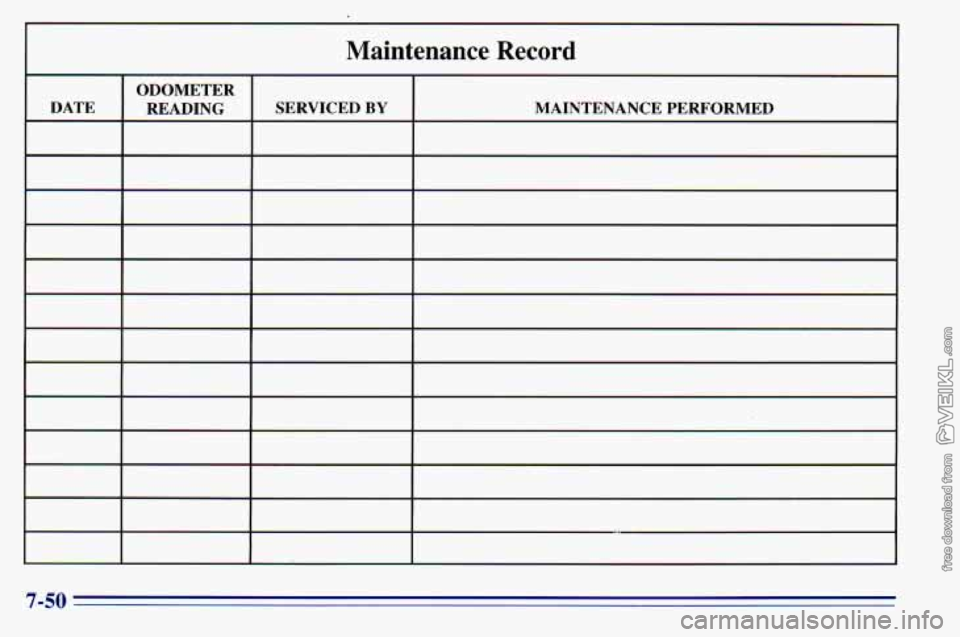
I
Maintenance Record
SERVICED BY MAINTENANCE PERFORMED
7 cn